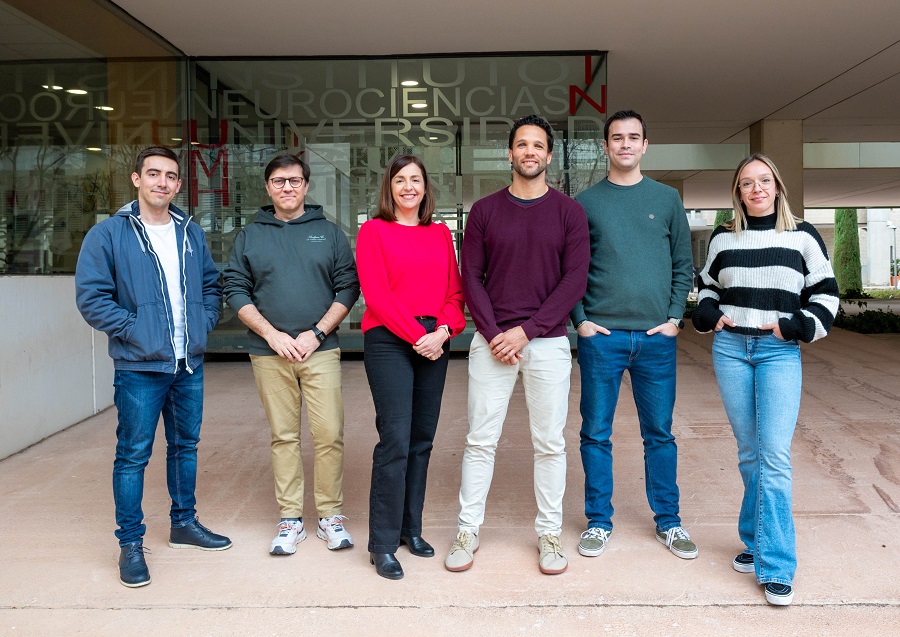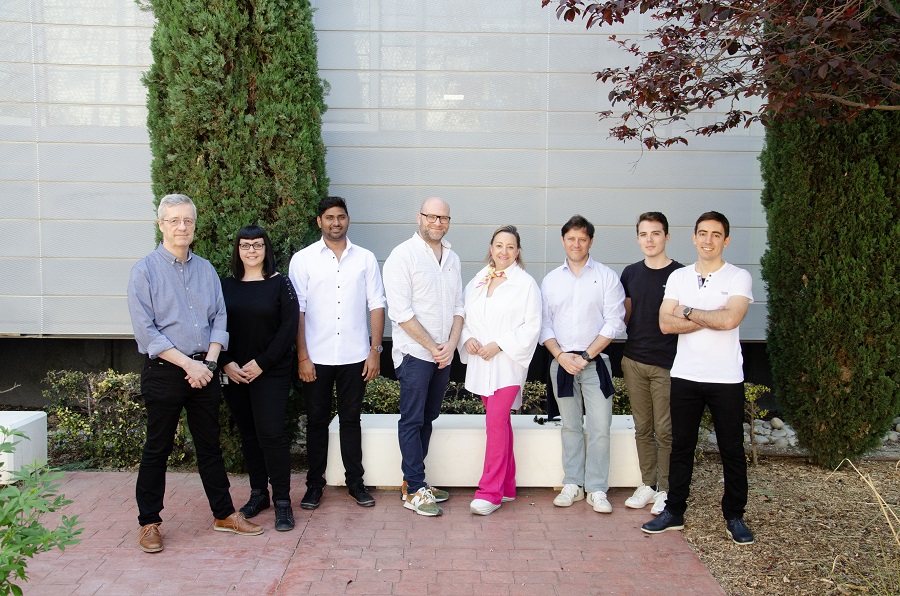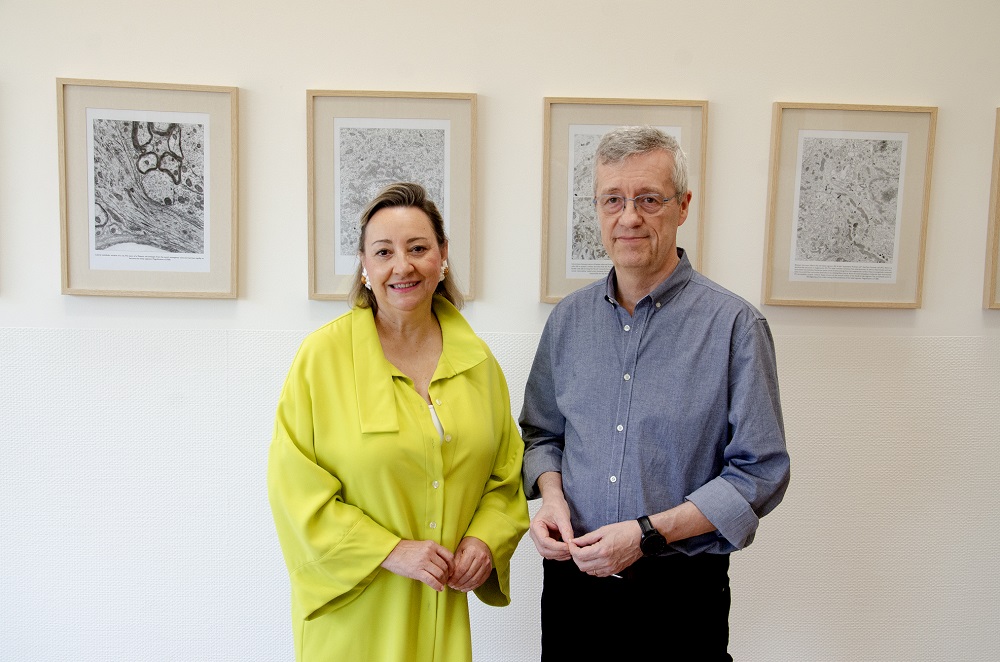Lines of investigation
Our main interest is the study of cell behaviour in development and disease, in particular associated with cell movements. We have been working on the process of epithelial to mesenchymal transition (EMT) fundamental for the development of tissues and organs which cells undergo massive cell migrations. We have also found that pathological activation of the EMT in the adult leads to several prominent pathologies. As such, aberrant activation of EMT in tumours leads to the acquisition of invasive and migratory properties. We have extended the study of some EMT inducing factors, such as Snail, to different pathologies. As such, an aberrant activation of Snail leads to the development of achondroplasia (the most common form of dwarfism in humans) and osteomalacia (bone demineralization in the adult). Going back to fundamental processes at early development, we have shown that the interplay between Snail factors and another transcription factor (Sox3) determines embryonic territories at gastrulation, ensuring the formation of the nervous system and more recently, we have found the mechanism that drives heart positioning.
Metastasis is the cause of the vast majority of cancer-associated deaths, but the underlying mechanisms remain poorly understood. The invasion and dissemination steps during carcinoma progression have been associated with EMT. However, we have shown that while EMT is important for the acquisition of motility and invasive properties in cancer cells, its abrogation is required for these migratory cancer cells to colonize distant organs and progress to the metastatic state. This also has an impact on the design of therapeutic strategies in cancer, as inhibiting EMT (and therefore, motility) when cells have already disseminated from the primary tumour will indeed favour metastasis formation.
The EMT has been also associated with the development of organ fibrosis, accompanied by massive accumulation of extracellular matrix, mainly collagen fibres secreted by an excess of myofibroblasts. Fibrosis appears in different organs such as the kidney, the liver, the lung or the heart and it concurs with a progressive reduction in organ function and eventual organ failure. Thus, it is crucial to understand the mechanisms by which fibrosis develops, and one key question is the origin of myofibroblasts, that has been debated until recently. Some data indicated that they were the result of an EMT undergone by the epithelial cells, while lineage analysis suggested that this was not the case. We have shown that the activation of EMT is required for development of renal fibrosis but, importantly, that renal epithelial cells are not the source of myofibroblasts. As such, fibrosis develops after renal epithelial cells undergo a partial EMT by which they dedifferentiate but remain integrated in the tubules. These damaged epithelial cells send signals to the interstitium that in turn favor (i) the differentiation of myofibroblasts from interstitial fibroblasts, and (ii) the recruitment of bone marrow-derived mesenchymal cells and macrophages, therefore favoring fibrogenesis and sustaining inflammation, the hallmarks of fibrosis. Furthermore, we have shown that fibrosis can be attenuated by the systemic injection of EMT inhibitors, opening new avenues for the treatment of fibrotic diseases.
In our studies we use mouse, chick and zebrafish as experimental models for loss or gain and function analyses together with cultured cells and samples from patients. We are currently interested in i) investigating new regulatory networks that control cell movements and plasticity, iii) tracking the movements of embryonic cells that regulate organ positioning, iv) tracking the movement and plasticity of cancer cells from the primary tumor to metastatic foci, and v) studying the complexity of cell plasticity to better understand organ formation and degeneration, aiming at proposing better therapeutic strategies.
Representative Publications
- Microglial reprogramming enhances antitumor immunity and immunotherapy response in melanoma brain metastases. Rodriguez-Baena FJ, Marquez-Galera A, Ballesteros Martínez P, Castillo A, Diaz E, Moreno-Bueno G, Lopez-Atalaya JP and Sanchez-Laorden B. Cancer Cell. 2025 43(3), 1–15 https://doi.org/10.1016/j.ccell.2025.01.008
- Intron detention tightly regulates the stemness/differentiation switch in the adult neurogenic niche. Gonzalez-Iglesias A, Arcas A, Domingo-Muelas A, Mancini E, Galcerán J, Valcárcel J, Fariñas I and Nieto MA. Nature Communications. 2024 15, 2837 https://doi.org/10.1038/s41467-024-47092-z
- Two distinct Epithelial to Mesenchymal Transition Programmes Control Invasion and Inflammation in Segregated Tumour Cell Populations. Kass Youssef, K., Narwade, N., Arcas, A., Marquez-Galera, A., Jiménez, R., Lopez-Blau, C., Fazilaty, H., García-Gutierrez, D., Cano, A., Galcerán, J., Moreno-Bueno, G., Lopez-Atalaya, J.P. and Nieto, M.A. Nature Cancer. 2024 https://doi.org/10.1038/s43018-024-00839-5
- The epithelial-mesenchymal transition in tissue degeneration and repair. Youssef, K.K. and Nieto, M.A. Nat. Rev. Mol. Cell. Biol. 2024 25, 720-739 https://doi.org/10.1038/s41580-024-00733-z
- Microenvironmental Snail1-induced immunosuppression promotes melanoma growth. Arumi-Planas M, Rodriguez-Baena FJ, Cabello-Torres F, Gracia F, Lopez-Blau C, Nieto MA, Sanchez-Laorden B. Oncogene 2023 42 (36), pp. 2659 - 2672 https://doi.org/10.1038/s41388-023-02793-5
- Metabolic rewiring induced by ranolazine improves melanoma responses to targeted therapy and immunotherapy. Redondo-Muñoz M, Rodriguez-Baena FJ, Aldaz P, Caballé-Mestres A, Moncho-Amor V, Otaegi-Ugartemendia M, Carrasco-Garcia E, Olias-Arjona A, Lasheras-Otero I, Santamaria E, Bocanegra A, Chocarro L, Grier A, Dzieciatkowska M, Bigas C, Martin J, Urdiroz-Urricelqui U, Marzo F, Santamaria E, Kochan G, Escors D, Larrayoz IM, Heyn H, D’Alessandro A, Stephan-Otto Attolini C, Matheu A, Wellbrock C, Aznar Benitah S, Sanchez-Laorden B & Arozarena I. Nature Metabolism. 2023 5 (9), pp. 1544 - 1562 https://doi.org/10.1038/s42255-023-00861-4
- A gene regulatory network to control EMT programs in development and disease Fazilaty H, Rago L, Kass Youssef K, Ocaña OH, Garcia-Asencio F, Arcas A, Galceran J, Nieto MA Nature Communications 2019 10:5115 https://doi.org/10.1038/s41467-019-13091-8
- MicroRNAs Establish the Right-Handed Dominance of the Heart Laterality Pathway in Vertebrates Rago L, Castroviejo N, Fazilaty H, Garcia-Asencio F, Ocaña OH, Galcerán J, Nieto MA Developmental Cell 2019 51(4):UNSP e3432 https://doi.org/10.1016/j.devcel.2019.09.012
- A right-handed signalling pathway drives heart looping in vertebrates Ocaña OH, Coskun H, Minguillon C, Murawala P, Tanaka EM, Galceran J, Muñoz-Chapuli R, Nieto MA Nature 2017 549(7670):86 https://doi.org/10.1038/nature23454
- EMT: 2016 Nieto MA, Huang RY, Jackson RA, Thiery JP Cell 2016 166(1):21 https://doi.org/10.1016/j.cell.2016.06.028
- Microglial reprogramming enhances antitumor immunity and immunotherapy response in melanoma brain metastases. Rodriguez-Baena FJ, Marquez-Galera A, Ballesteros Martínez P, Castillo A, Diaz E, Moreno-Bueno G, Lopez-Atalaya JP and Sanchez-Laorden B. Cancer Cell. 2025 43(3), 1–15 https://doi.org/10.1016/j.ccell.2025.01.008
- Neural crest development and disorders: from patient to model system and back again – the NEUcrest conference. Marco Antonaci , Amy Kerr, Merin Lawrence , Francesca Lorenzini , Nitin Narwade , Chloé Paka, Anna Magdalena Wulf Biology Open. 2024 13: issue 6, June 2024 https://doi.org/10.1242/bio.060530
- The epithelial-mesenchymal transition in tissue degeneration and repair. Youssef, K.K. and Nieto, M.A. Nat. Rev. Mol. Cell. Biol. 2024 25, 720-739 https://doi.org/10.1038/s41580-024-00733-z
- Two distinct Epithelial to Mesenchymal Transition Programmes Control Invasion and Inflammation in Segregated Tumour Cell Populations. Kass Youssef, K., Narwade, N., Arcas, A., Marquez-Galera, A., Jiménez, R., Lopez-Blau, C., Fazilaty, H., García-Gutierrez, D., Cano, A., Galcerán, J., Moreno-Bueno, G., Lopez-Atalaya, J.P. and Nieto, M.A. Nature Cancer. 2024 https://doi.org/10.1038/s43018-024-00839-5
- Intron detention tightly regulates the stemness/differentiation switch in the adult neurogenic niche. Gonzalez-Iglesias A, Arcas A, Domingo-Muelas A, Mancini E, Galcerán J, Valcárcel J, Fariñas I and Nieto MA. Nature Communications. 2024 15, 2837 https://doi.org/10.1038/s41467-024-47092-z
- Neuronal Cannabinoid CB1 Receptors Suppress the Growth of Melanoma Brain Metastases by Inhibiting Glutamatergic Signalling. Costas-Insua, C.; Seijo-Vila, M.; Blázquez, C.; Blasco-Benito, S.; Rodríguez-Baena, F.J.; Marsicano, G.; Pérez-Gómez, E.; Sánchez, C.; Sánchez-Laorden, B.; Guzmán, M. Cancers . 2023 15: 2439 https://doi.org/10.3390/cancers15092439
- Metabolic rewiring induced by ranolazine improves melanoma responses to targeted therapy and immunotherapy. Redondo-Muñoz M, Rodriguez-Baena FJ, Aldaz P, Caballé-Mestres A, Moncho-Amor V, Otaegi-Ugartemendia M, Carrasco-Garcia E, Olias-Arjona A, Lasheras-Otero I, Santamaria E, Bocanegra A, Chocarro L, Grier A, Dzieciatkowska M, Bigas C, Martin J, Urdiroz-Urricelqui U, Marzo F, Santamaria E, Kochan G, Escors D, Larrayoz IM, Heyn H, D’Alessandro A, Stephan-Otto Attolini C, Matheu A, Wellbrock C, Aznar Benitah S, Sanchez-Laorden B & Arozarena I. Nature Metabolism. 2023 5 (9), pp. 1544 - 1562 https://doi.org/10.1038/s42255-023-00861-4
- Microenvironmental Snail1-induced immunosuppression promotes melanoma growth. Arumi-Planas M, Rodriguez-Baena FJ, Cabello-Torres F, Gracia F, Lopez-Blau C, Nieto MA, Sanchez-Laorden B. Oncogene 2023 42 (36), pp. 2659 - 2672 https://doi.org/10.1038/s41388-023-02793-5
- Antifibrotic drugs as therapeutic tools in resistant melanoma. Sanchez-Laorden B, Nieto MA. EMBO Mol Med. 2022 14(3):e15449 - Editorial https://doi.org/10.15252/emmm.202115449
- Are You Interested or Afraid of Working on EMT? Nieto MA Methods Mol Biol 2021 2179:19 https://doi.org/10.1007/978-1-0716-0779-4_4
- Cilia, ciliopathies and hedgehog-related forebrain developmental disorders Andreu-Cervera A, Catala M, Schneider-Maunoury S Neurobiol Dis 2021 150:105236 https://doi.org/10.1016/j.nbd.2020.105236
- The evolutionary history of Ephs and ephrins: towards multicellular organisms Arcas A, Wilkinson DG, NietoMA Mol Biol Evol 2020 37(2):379 https://doi.org/10.1093/molbev/msz222
- 50+shades of EMT in 20 years of embryo-cancer bonding Nieto MA Nat Rev Mol Cell Biol 2020 21(10):563 https://doi.org/10.1038/s41580-020-00287-w
- Genetic Fate Mapping of Transient Cell Fate Reveals N-Cadherin Activity and Function in Tumor Metastasis Li Y, Lv Z, Zhang S, Wang Z, He L, Tang M, Pu W, Zhao H, Zhang Z, Shi Q, Cai D, Wu M, Hu G, Lui KO, Feng J, Nieto MA, Zhou B Dev Cell 2020 54(5):593 https://doi.org/10.1016/j.devcel.2020.06.021
- Glucose Metabolism Takes Center Stage in Epithelial-Mesenchymal Plasticity Kass Youssef K, Nieto MA Dev Cell 2020 53(2):133 https://doi.org/10.1016/j.devcel.2020.03.021
- G-protein-coupled receptor kinase 2 safeguards epithelial phenotype in head and neck squamous cell carcinomas Palacios-Garcia J, Sanz-Flores M, Asensio A, Alvarado R, Rojo-Berciano S, Stamatakis K, Paramio JM, Cano A, Nieto MA, Garcia-Escudero R, Mayor F Jr, Ribas C Int J Cancer 2020 147(1):218 https://doi.org/10.1002/ijc.32838
- Guidelines and definitions for research on epithelial-mesenchymal transition Yang J, Antin P, Berx G, Blanpain C, Brabletz T, Bronner M, Campbell K, Cano A, Casanova J, Christofori G, Dedhar S, Derynck R, Ford HL, Fuxe J, García de Herreros A, Goodall GJ, Hadjantonakis AK, Huang RJY, Kalcheim C, Kalluri R, Kang Y, Khew-Goodall Y, Levine H, Liu J, Longmore GD, Mani SA, Massagué J, Mayor R, McClay D, Mostov KE, Newgreen DF, Nieto MA, Puisieux A, Runyan R, Savagner P, Stanger B, Stemmler MP, Takahashi Y, Takeichi M, Theveneau E, Thiery JP, Thompson EW, Weinberg RA, Williams ED, Xing J, Zhou BP, Sheng G, EMT International Association (TEMTIA) Nat Rev Mol Cell Biol 2020 21(6):341 https://doi.org/10.1038/s41580-020-0237-9
- In primary airway epithelial cells, the unjamming transition is distinct from the epithelial-to-mesenchymal transition Mitchel JA, Das A, O'Sullivan MJ, Stancil IT, DeCamp SJ, Koehler S, Ocaña OH, Butler JP, Fredberg JJ, Nieto MA, Bi D, Park JA Nat Commun 2020 11(1):5053 https://doi.org/10.1038/s41467-020-18841-7
- Proliferation and EMT trigger heart repair Gonzalez-Iglesias A, Nieto MA Nat Cell Biol 2020 22(11):1291 https://doi.org/10.1038/s41556-020-00594-6
- Reply to: Zebrafish prrx1a mutants have normal hearts Castroviejo N, Ocaña OH, Rago L, Coskun H, Arcas A, Galcerán J, Nieto MA Nature 2020 585(7826):E17 https://doi.org/10.1038/s41586-020-2675-0
- A gene regulatory network to control EMT programs in development and disease Fazilaty H, Rago L, Kass Youssef K, Ocaña OH, Garcia-Asencio F, Arcas A, Galceran J, Nieto MA Nature Communications 2019 10:5115 https://doi.org/10.1038/s41467-019-13091-8
- MicroRNAs Establish the Right-Handed Dominance of the Heart Laterality Pathway in Vertebrates Rago L, Castroviejo N, Fazilaty H, Garcia-Asencio F, Ocaña OH, Galcerán J, Nieto MA Developmental Cell 2019 51(4):UNSP e3432 https://doi.org/10.1016/j.devcel.2019.09.012
- Ribosome biogenesis during cell cycle arrest fuels EMT in development and disease Prakash V, Carson BB, Feenstra JM, Dass RA, Sekyrova P, Hoshino A, Petersen J, Guo Y, Parks MM, Kurylo CM, Batchelder JE, Haller K, Hashimoto A, Rundqivst H, Condeelis JS, Allis CD, Drygin D, Nieto MA, Andäng M, Percipalle P, Bergh J, Adameyko I, Farrants AÖ, Hartman J, Lyden D, Pietras K, Blanchard SC, Vincent CT Nature Communications 2019 10:2110 https://doi.org/10.1038/s41467-019-10100-8
- A snail tale and the chicken embryo Nieto MA Int J Dev Biol 2018 62(1-3):121 https://doi.org/10.1387/ijdb.170301mn
- EMT in cancer Brabletz T, Kalluri R, Nieto MA, Weinberg RA Nat Rev Cancer 2018 18(2):128 https://doi.org/10.1038/nrc.2017.118
- Functional interplay between secreted ligands and receptors in melanoma Herraiz C, Jiménez-Cervantes C, Sánchez-Laorden B, García-Borrón JC Semin Cell Dev Biol 2018 78:73 https://doi.org/10.1016/j.semcdb.2017.06.021
- Upholding a role for EMT in breast cancer metastasis Ye X, Brabletz T, Kang Y, Longmore GD, Nieto MA, Stanger BZ, Yang J, Weinberg RA Nature 2017 547(7661):E1 https://doi.org/10.1038/nature22816
- A right-handed signalling pathway drives heart looping in vertebrates Ocaña OH, Coskun H, Minguillon C, Murawala P, Tanaka EM, Galceran J, Muñoz-Chapuli R, Nieto MA Nature 2017 549(7670):86 https://doi.org/10.1038/nature23454
- Snail2 and Zeb2 repress P-cadherin to define embryonic territories in the chick embryo Acloque H, Ocana OH, Abad D, Stern CD, Nieto MA Development 2017 144(4):649 https://doi.org/10.1242/dev.142562
- Upholding a role for EMT in pancreatic cancer metastasis Aiello NM, Brabletz T, Kang Y, Nieto MA, Weinberg RA, Stanger BZ Nature 2017 547(7661):E7 https://doi.org/10.1038/nature22963
- DDRprot: a database of DNA damage response-related proteins Andres-Leon E, Cases I, Arcas A, Rojas AM Database (Oxford) 2016 baw123 https://doi.org/10.1093/database/baw123
- EMT: 2016 Nieto MA, Huang RY, Jackson RA, Thiery JP Cell 2016 166(1):21 https://doi.org/10.1016/j.cell.2016.06.028
- Identification of p53-target genes in Danio rerio Mandriani B, Castellana S, Rinaldi C, Manzoni M, Venuto S, Rodriguez-Aznar E, Galceran J, Nieto MA, Borsani G, Monti E, Mazza T, Merla G, Micale L Sci Rep 2016 6:32474 https://doi.org/10.1038/srep32474
- Molecular Mechanisms Controlling the Migration of Striatal Interneurons Villar-Cerviño V, Kappeler C, Nobrega-Pereira S, Henkemeyer M, Rago L, Nieto MA, Marin O J Neurosci 2015 35(23):8718 https://doi.org/10.1523/JNEUROSCI.4317-14.2015
- Snail1-induced partial epitelial-to-mesenchymal transition drives renal fibrosis in mice and can be targeted to reverse established disease Grande MT, Sanchez-Laorden B, Lopez-Blau C, de Frutos CA, Boutet A, Arevalo M, Grant Rowe R, Weiss SJ, Lopez-Novoa JM, Nieto MA Nat Med 2015 21(9):989 https://doi.org/10.1038/nm.3901
- Scratch2 prevents cell cycle re-entry by repressing miR-25 in postmitotic primary neurons Rodriguez-Aznar E, Barrallo-Gimeno A, Nieto MA J Neurosci 2013 33(12):5095 https://doi.org/10.1523/JNEUROSCI.4459-12.2013
- eEF1A Mediates the Nuclear Export of SNAG-Containing Proteins via the Exportin5-Aminoacyl-tRNA Complex Mingot JM, Vega S, Cano A, Portillo F, Nieto MA Cell Rep 2013 5(3):727 https://doi.org/10.1016/j.celrep.2013.09.030
- Epithelial plasticity: a common theme in embryonic and cancer cells Nieto MA Science 2013 342(6159):1234850 https://doi.org/10.1126/science.1234850
- The epithelial-mesenchymal transition under control: Global programs to regulate epithelial plasticity Nieto MA, Cano A Semin Cancer Biol 2012 22:361 https://doi.org/10.1016/j.semcancer.2012.05.003
- The endogenous retrovirus ENS-1 provides active binding sites for transcription factors in embryonic stem cells that specify extra embryonic tissue Mey A, Acloque H, Lerat E, Gounel S, Tribollet V, Blanc S, Curton D, Birot AM, Nieto MA, Samarut J Retrovirology 2012 9:21 https://doi.org/10.1186/1742-4690-9-21
- Mutual exclusion of transcription factors and cell behaviour in the definition of vertebrate embryonic territories Acloque H, Ocaña OH, Nieto MA Curr Opin Genet Dev 2012 22(4):308 https://doi.org/10.1016/j.gde.2012.03.004
- Metastatic Colonization Requires the Repression of the Epithelial-Mesenchymal Transition Inducer Prrx1 Ocaña OH, Corcoles R, Fabra A, Moreno-Bueno G, Acloque H, Vega S, Barrallo-Gimeno A, Cano A, Nieto MA Cancer Cell 2012 22(6):709 https://doi.org/10.1016/j.ccr.2012.10.012
- Lats2 kinase potentiates Snail1 activity by promoting nuclear retention upon phosphorylation Zhang K, Rodriguez-Aznar E, Yabuta N,Owen RJ, Mingot JM, Nojima H, Nieto MA, Longmore GD EMBO J 2012 31(1):29 https://doi.org/10.1038/emboj.2011.357
- An interview with Angela Nieto Interviewed by Eva Amsen Nieto MA Development 2012 139(7):1227 https://doi.org/10.1242/dev.077826
- Reciprocal Repression between Sox3 and Snail Transcription Factors Defines Embryonic Territories at Gastrulation Acloque H, Ocaña OH, Matheu A, Rizzoti K, Wise C, Lovell-Badge R, Nieto MA Dev Cell 2011 21(3):546 https://doi.org/10.1016/j.devcel.2011.07.005
- Repression of Puma by Scratch2 is required for neuronal survival during embryonic development Rodriguez-Aznar E, Nieto MA Cell Death Differ 2011 18(7):1196 https://doi.org/10.1038/cdd.2010.190
- Thanatophoric Dysplasia Type II With Encephalocele and Semilobar Holoprosencephaly: Insights Into Its Pathogenesis Martinez-Frias ML, Egues X, Puras A, Hualde J, De Frutos CA, Bermejo E, Nieto MA, Martinez S Am J Med Genet A 2011 155A(1):197 https://doi.org/10.1002/ajmg.a.33765
- The ins and Outs of the Epithelial to Mesenchymal Transition in Health and Disease Nieto MA Annu Rev Cell Dev Biol 2011 27:347 https://doi.org/10.1146/annurev-cellbio-092910-154036
- An Epigenetic Mark that Protects the Epithelial Phenotype in Health and Disease Heredia F, Nieto MA Cell Stem Cell 2011 8(5):462 https://doi.org/10.1016/j.stem.2011.04.011
- Deletion of H-Ras decreases renal fibrosis and myofibroblast activation following ureteral obstruction in mice Grande MT, Fuentes-Calvo I, Arevalo M, Heredia F, Santos E, Martinez-Salgado C, Rodriguez-Puyol D, Nieto MA, Lopez-Novoa JM, Martinez E Kidney Int 2010 77(6):509 https://doi.org/10.1038/ki.2009.498
- Epithelial plasticity, stemness and pluripotency Ocaña OH, Nieto MA Cell Res 2010 20(10):1086 https://doi.org/10.1038/cr.2010.127
- Review of the Recently Defined Molecular Mechanisms Underlying Thanatophoric Dysplasia and Their Potential Therapeutic Implications for Achondroplasia Martinez-Frias ML, De Frutos CA, Bermejo E, Nieto MA; ECEMC Working Group Am J Med Genet A 2010 152A(1):245 https://doi.org/10.1002/ajmg.a.33188
- Snail1 suppresses TGF-beta-induced apoptosis and is sufficient to trigger EMT in hepatocytes Franco DL, Mainez J, Vega S, Sancho P, Murillo MM, De Frutos CA, Del Castillo G, Lopez-Blau C, Fabregat I, Nieto MA J Cell Sci 2010 123(20):3467 https://doi.org/10.1242/jcs.068692

 Español
Español




